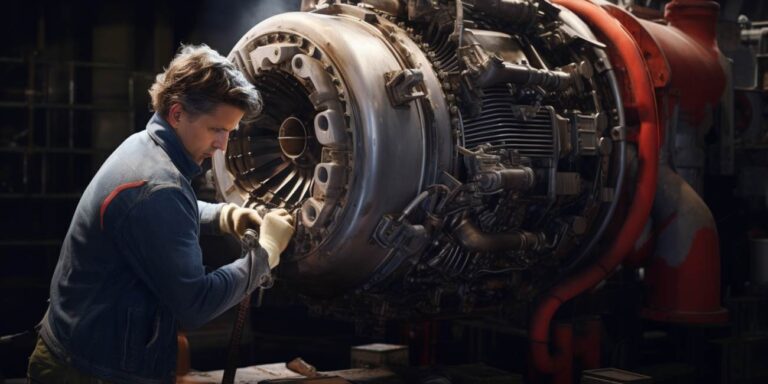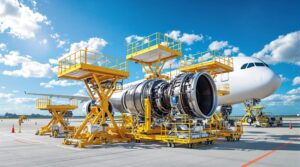Aircraft mechanics are the unsung heroes behind the scenes, conducting routine inspections to detect and address any potential issues before they escalate. This involves scrutinizing the aircraft’s engines, hydraulics, and avionics systems with precision. They diagnose problems using advanced tools and technology, troubleshooting to pinpoint issues swiftly.
In the vast hangars where these skilled professionals operate, teamwork is paramount. Collaborating with other mechanics, engineers, and technicians, they collectively contribute to the seamless functioning of the aviation industry. Each mechanic is a cog in the complex machinery that ensures aircraft safety and passenger well-being.
As the aviation sector advances, aircraft mechanics continually update their knowledge. Staying abreast of the latest technological advancements is crucial, enabling them to adapt to new aircraft models and innovations. This dedication to ongoing learning showcases their commitment to excellence in aircraft maintenance.
Time management is another critical aspect of an aircraft mechanic’s routine. With aircraft often operating on tight schedules, any delays due to maintenance issues can have cascading effects. Hence, mechanics meticulously plan and execute their tasks, adhering to strict timelines without compromising on quality.
Additionally, documentation plays a pivotal role in an aircraft mechanic’s day. Accurate and detailed records of maintenance activities, repairs, and inspections are maintained. This not only fulfills regulatory requirements but also serves as a valuable resource for future preventive maintenance and analysis.
Summing up, the life of an aircraft mechanic is a delicate dance of technical prowess, teamwork, and time management. Their unwavering dedication ensures that the wings of aviation remain not just airborne but soaring to new heights.
How to become a licensed aircraft mechanic and what are the job responsibilities
Becoming a licensed aircraft mechanic involves a blend of education, hands-on experience, and certification. Typically, this journey starts with completing a Federal Aviation Administration (FAA)-approved aviation maintenance technician program or gaining equivalent experience through on-the-job training. These programs cover essential aspects of aircraft mechanics, including airframe and powerplant systems, avionics, engines, and regulations.
After completing the educational requirements, aspiring mechanics must gain practical experience working on aircraft. This usually involves accumulating a certain number of hours working under the supervision of a certified mechanic. The actual duration varies based on the program and the specific qualifications required by the FAA.
Once the education and experience prerequisites are met, candidates need to pass a series of exams administered by the FAA. These exams evaluate knowledge of relevant regulations, maintenance procedures, and troubleshooting techniques. Successful completion leads to obtaining the Airframe and Powerplant (A&P) certificate, which is the key to becoming a licensed aircraft mechanic.
Job responsibilities for licensed aircraft mechanics are diverse and crucial for aviation safety. They encompass performing routine inspections, repairs, and maintenance tasks on aircraft components like engines, landing gear, brakes, and electrical systems. Mechanics must follow stringent safety protocols and meticulously adhere to maintenance manuals and manufacturer guidelines.
Moreover, these professionals are responsible for diagnosing mechanical or electrical issues, troubleshooting problems, and ensuring that all components meet safety standards before an aircraft takes flight. This role demands meticulous attention to detail, as even minor oversights can have significant consequences in aviation.
In addition to repairs and maintenance, aircraft mechanics also conduct regular inspections to comply with FAA regulations. These inspections involve examining aircraft structures and systems, identifying potential issues, and performing necessary repairs or replacements to maintain airworthiness.
Furthermore, staying updated with technological advancements in aircraft systems and tools is imperative for licensed mechanics. They need to continuously learn and adapt to new technologies, including advancements in avionics, composite materials, and computer-based diagnostic tools.
| Key Responsibilities | Key Skills |
|---|---|
|
|
What does an aircraft inspector do and what are the job requirements
An aircraft inspector plays a critical role in ensuring the safety and functionality of aircraft. This professional is responsible for the inspection and oversight of various components, systems, and structures, guaranteeing that they meet the highest standards of quality and compliance.
The primary focus of an aircraft inspector is to conduct thorough inspections on aircraft, ranging from small private planes to large commercial jets. These inspections involve a meticulous examination of the aircraft’s exterior and interior, including its engines, avionics, landing gear, and other vital components. The goal is to identify any potential issues or discrepancies that could compromise the airworthiness of the aircraft.
One key aspect of an aircraft inspector’s role is to ensure that all maintenance activities adhere to strict guidelines and regulations. They collaborate closely with maintenance teams to review and approve maintenance procedures, records, and documentation. This collaboration is crucial in maintaining the overall integrity of the aircraft and achieving and sustaining its airworthiness status.
Ensuring airworthiness involves more than just routine inspections; it also requires a deep understanding of aviation regulations and industry standards. An aircraft inspector must stay updated on the latest developments in aviation technology, safety protocols, and maintenance practices. This knowledge is vital in making informed decisions regarding the certification of an aircraft.
When it comes to certification, the aircraft inspector serves as a gatekeeper, verifying that an aircraft meets all the necessary requirements before it can be deemed airworthy. This involves a meticulous review of documentation, maintenance logs, and inspection reports. The certification process is a critical step in ensuring that an aircraft is fit for operation and poses no undue risk to passengers and crew.
Types of aircraft mechanics jobs by area of specialization
Aircraft mechanics play a crucial role in ensuring the safety and functionality of airplanes. These skilled professionals specialize in different areas of aircraft maintenance, including avionics, powerplant, and airframe.
Avionics specialists focus on the electronic systems within an aircraft. This includes navigation instruments, communication equipment, and monitoring systems. These experts ensure that the aircraft’s avionic systems operate efficiently, contributing to safe and precise flight. Avionics mechanics undergo specialized training to troubleshoot and repair the intricate electronic components that keep modern aircraft connected and in control.
Powerplant mechanics are responsible for the aircraft’s engines and propulsion systems. Their expertise lies in maintaining and repairing the various components that power the aircraft, including engines, fuel systems, and associated controls. Powerplant mechanics play a vital role in optimizing engine performance, conducting regular inspections, and addressing any issues that may arise during the aircraft’s lifespan.
Airframe specialists focus on the structural elements of an aircraft, ensuring its integrity and aerodynamic efficiency. This includes the fuselage, wings, and other components that make up the aircraft’s physical structure. Airframe mechanics inspect for any signs of wear, corrosion, or damage, and perform necessary repairs or replacements to maintain the aircraft’s structural integrity. Their work contributes to the overall safety and longevity of the aircraft.
Each area of specialization requires a distinct skill set, and aircraft mechanics may choose to specialize in one or more of these crucial domains. The collaboration of avionics, powerplant, and airframe specialists is essential for comprehensive aircraft maintenance. To highlight the differences between these specialties, consider the following table:
| Specialization | Main Focus | Key Responsibilities |
|---|---|---|
| Avionics | Electronic Systems | Navigation instruments, communication equipment, troubleshooting, and repairs of avionic components. |
| Powerplant | Engines and Propulsion | Maintenance and repair of engines, fuel systems, and associated controls. |
| Airframe | Structural Elements | Inspection, repair, and replacement of the aircraft’s physical structure, including fuselage and wings. |
Choosing a specialization often depends on personal interest, career goals, and the specific challenges that mechanics find most engaging. Regardless of their chosen area, aircraft mechanics contribute significantly to the aviation industry’s overall safety and efficiency.






